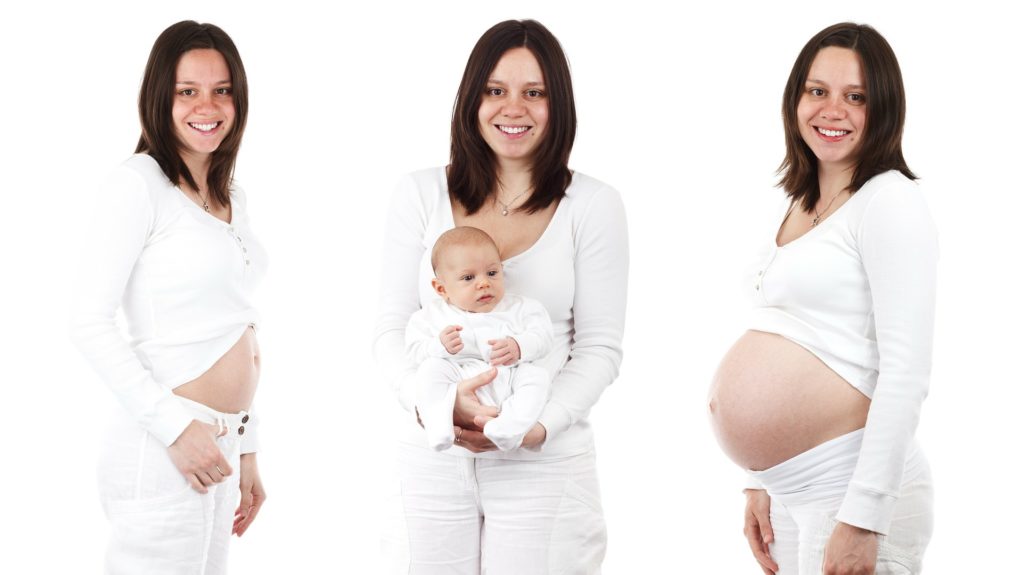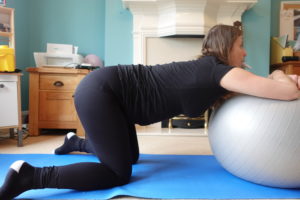
Why a Pelvic Floor Rehabilitation is essential after every Pregnancy?
In France, Women automatically have 10 Physiotherapy sessions with a women’s health specialist after they give birth. This isn’t because they like to offer free treatments!
They are simply well aware that providing adequate post natal care prevents issues on the short and long term, saving a lot of inconvenience for the mothers by tackling these issues from the start and ultimately a significant amount of money by preventing the need for surgery 5 to 10 years later.
Let’s review the common issues associated with pregnancy and giving birth, and how Pelvic Floor Rehabilitation & Abdominal Rehabilitation can heal or help prevent them!
30% to 50% of women suffer from this condition… Effort urinary inctoninence is characterized by urine leakage (not preceded by urgency) occurring when sneezing, laughing, coughing, and lifting or during physical activities (running, jumping…). In extreme cases, even walking can trigger it. This type of incontinence is due to a brutal abdominal pressure increase causing leaking through either hypermobility of the urethral canal (urinary canal) or sphincter failure (weakness of muscles blocking the urethra).
To learn more about this condition have look at this article:
What type of incontinence do you have
Urinary incontinence by urgency is an involuntary urine leakage preceded by compelling urge to urinate, leading sometimes to complete urination. This type of incontinence is caused by an involuntary contraction of the bladder and it is not link to physical activity. It is named instable bladder or hyperactive bladder. It can appear in certain situation associated with reflex micturition such as incontrollable laugh, fear, orgasm…
To learn more about anal incontinence mechanism, cause and treatment, you can read this article:
What type of incontinence do you have
For urgency management and treatment:
How to manage urgency
Video of a technique to manage urgency:
Throughout the pregnancy, your belly and abdominal muscles are weaker and stretch to create space for your baby. When these abdominal muscles are too strong before the pregnancy or the belly developed too quickly, the linea alba between rectus abdominis (6 packs muscle) tears leaving a gap above and below your belly button. It is named Diastasis. To know if you have a diastasis, after giving birth, you have to lie down on your back with knees bend and feet on the floor. Put 3 fingers underneath your belly button and press gently. Raise your head, if your fingers are blocked, there is no diastasis. If your fingers go deeper, there is a diastasis. Warning: do it only once as the repetition of this test can increase the diastasis. To learn how to treat diastasis please have look at:
Abdominal rehab
it is common to experience articular pain after delivery (wrist, ankle, pelvis, back,….):
- Lower back pain are most of the time due to sacro-iliac joint (pelvis joint) inflamation with or without irradiation in your legs as a sciatica
- Pubic symphysis pain (maybe you had a SPD during pregnancy so you already know this pain!): You can feel a burning pain in between your legs, especially when closing or shearing your legs (walking or rolling over)
To learn more on how to manage these symptoms have a look at:
How to restore pelvis balance
After giving birth, going back to sport may be prevent by a sensation of heaviness in the lower abdomen or by leakage due to effort incontinence (see above).
What happen during physical activity?
When performing a physical activity continence (ability to hold urine) is maintain if the strength of your sphincter muscles (pelvic floor anatomy => here) is superior to the vesical pressure (=pressure inside your bladder). If the pressure inside your bladder exceeds your sphincters strength, a leakage appears (also called stress incontinence). This increase of vesical pressure can be caused by:
- An increase of pressure within your abdomen. Caused for example by contraction of rectus abdominis (6 packs muscles)
- A strong impact (jump or even when running) bringing all your internal organ down against your pelvic floor
Similarly, this increase of pressure associated with a weak pelvic floor may be the cause of the heaviness sensation. To learn more about how to get back to sport after giving birth, have a read at:
Sport after giving birth
A prolapse is a temporary or permanent lowering of one or more pelvic organs. They will push and deform the vaginal wall, creating a bump on the perineum or even exiting through the vagina. One woman out of 3 over 50 years old has a prolapse, often minor and symptomless. However, prolapses worsen and become symptomatic, especially pass 60 years old. Women describe a vaginal ball, a sensation of something going down or/and of heaviness. Before to explain what a prolapse is, it is essential to understand how the concerning organs sit inside our abdomen. For more details have a look at our blog on the topic:
Prolapse
Anal incontinence is characterized by difficulty or incapacity to keep gas or stools. Throughout the pregnancy, baby is supported by a hammock composed of the pelvic floor muscles, which also surround urethra, vagina and anus. Consequently, pregnancy imposed important pressure on these pelvic floor muscles, stretching them and leading to their weakening. During the labour, baby delivery as well as episiotomy or tear will stretch or cut the perineum from the vaginal part to the anal part. In some case, the tear can rip apart the external anal sphincter. To learn more about anal incontinence mechanism, cause and treatment, you can read this article:
What type of incontinence do you have ?
Pain may be present due to scare adhesion of episiotomy, tear or C-section. Hypotonic perineum (pelvis floor muscle weakness) is also a common issue which may lead to loss of sensation. Main dysfunction are classified as followed:
- Genital pain caused by sexual intercourse are called Dyspareunies
- Involuntary contraction of perineal muscle preventing penetration is named Vaginisme
- Sometimes there is also an incapacity to have an orgasm which is called Anorgasmie
- To have more on this topic, have a look at:
Your sex life after a baby
Even if you don’t suffer from any of the above after giving birth, Pelvic Floor Rehabilitation and Abdominal Rehabilitation remains a must do!
Even if you don’t notice any major symptoms, it’s likely you suffer of some degree of pelvic/abdominal dysfunction such as a muscular weakness or a loss of control. It may sound like nothing, but it may have major repercussions.
Unfortunately, we have a ton of story of patients who went too quickly or inadequately, after birth without proper supervision/check, into a physical activity and injured themselves. A perfect example is a patient of ours, who is a Pilates instructor, she hadn’t recovered a correct control of her abdominal muscles and despite Pilates being a fairly safe physical activity, she tore her linea alba (line in-between your abds) performing one hundreds…
See why some abs exercises are dangerous for your pelvic floor and abdominal muscles:
Good and bad abdominal exercises
We also often hear: “I had a C-section, I don’t need a pelvic floor rehabilitation”. Sadly, it is forgetting that delivery is not the only stress put on your pelvic floor, throughout your pregnancy, hormones and the weight of your baby stretch these muscles and lead to their weakening. Additionally, even though C-section is less traumatic than a vaginal birth for your pelvic floor muscles, it is really more traumatic for your abdominal muscles! Keep in mind a C-section consists of cutting through all the abdominal layers including your abdominal muscles… Meaning they suffered a major injury.
To learn more about C-section have a read at:
What is a c-section ?
For more details about abdominal rehabilitation:
Abdominal-rehab
Weakness and loss of control of your pelvic floor muscles may in the long term lead to major issues such as prolapse, necessitating surgery… Particularly at menopausal age, when you experience another massive hormonal change, these initially “minor” issues can drastically increase. So it’s better to tackle the problem from the start!
How pregnancy change your body ?
In any case, Pelvic Floor Rehabilitation and Abdominal Rehabilitation enhances recovery after giving birth. It takes 9 months to give life, but also 9 months to recover after.
It shouldn’t be considered a luxury to receive medical help after a pregnancy, as you received during your pregnancy. Both because it will make future pregnancies easier especially if you plan to have them close one to the other (when you run a marathon your try to recover before trying to run a second one…) and also because to take care of your new born you need to be at your best. We often have new mums who feel guilty to take time for themselves while on the contrary it’s essential to take this time to recover fully and be at your best for your baby!
With this review of common post-natal issues, we don’t aim to frighten anyone, on the contrary. We are French physiotherapists and were very surprised when we arrived in London to discover the lack of information provided to pregnant women and new mums. Therefore, with our Blog and YouTube Channel we aim to inform but also to provide solutions, like with the video below giving a quick introduction to the Abdo-MG method with a simple breathing exercise to retrain your abs after pregnancy.
So now that we understood Why a Pelvic Floor Rehabilitation is essential after every Pregnancy, let’s see how Pelvic Floor Rehabilitation and Abdominal Rehabilitation works and helps to solve/prevent the issues encountered after giving birth!
How Pelvic Floor Rehabilitation works and prevent post-natal issues?
Pelvic Floor Rehabilitation & Abdominal Rehabilitation are global methods aiming to understand the specific needs of each woman and provide them with a tailored treatment.
First session always starts with a history taking to help the women’s health physiotherapist to understand the problems you are presenting with (pain, urinary issues, sexual dysfunction, constipation or difficulty to hold gas…) but also who you are and how they affect your life.
In a second time, the women’s health physiotherapist will examine both your hip bones and abdomen to evaluate the position of your pelvis and detect a potential diastasis. Then, the women health physiotherapist will perform a vaginal touch to evaluate pelvic floor muscles tonicity, bladder static and, correct position of uterus and rectum.
Following the history taking and examination, in accordance with you, a tailored rehabilitation will be defined. It may include (comment in braquet are just an indication but these treatments work as whole and only your women’s health physiotherapist can determine the adapted techniques to use):
Thanks to this check, the women’s health physiotherapist will be able to determine if your pelvis bones and joints regained their initial position and if there are still mobile like in the pregnancy. Pelvis bone closing is actually a long process, which you can enhance with pelvic floor rehabilitation but also following simple advice presented here:
How to restore pelvis balance ?
Additionally, various pain may be present after pregnancy due to joint stuck in a position or inflamed such as:
- Sacro-iliac joint (your pelvis joints on the back) pain: often localised in your lower back.
- Pubis symphysis (the pelvis joints on the front) pain: really common at the end of the pregnancy which can prevent you from walking. It normally goes away after birth but there are always exceptions!
- Coccyx pain: You can feel it when you sit down or when you stand up. If you gave birth lying on your back with legs up, your sacrum or your coccyx may have moved backward or slightly on the side leading to muscles/articular tension and pain.
For all these pain the best it is to see a therapist (women’s health physiotherapist or osteopath). He/she will be able to manipulate and decrease the joints inflammation/pain. However, in the meantime try to mobilise gently your pelvis joints with gently exercises like in this playlist:
Internal examination is essential to evaluate a potential scare or episiotomy but also to determine if your pelvic floor muscles are too tense, weak and if you are able to contract them. Our patients commonly think they are using their pelvic floor muscles while they squeeze their abs, psoas or adductor muscles instead (all these muscles are around your pelvis). It is the limit of the Keggel exercises and so on. Without proper supervision, there is a risk to engage the wrong group of muscles without realising it. Not only you are not engaging/strengthening your pelvic floor muscles but you might end up creating more damage.
For example, by squeezing your abs (rectus abdominus) instead of your pelvic floor you will increase your intra-abdominal pressure harming your pelvic floor. To put it clearly, instead of engaging gently your pelvic floor to improve its function, you are pushing/smashing on it which might lead to prolapse…
Internal treatment help to relax tense muscle decreasing pain occurring during intercourse. It also a great technique to improve scar and episiotomy elasticity to diminish related pain but also prepare for potential future birth!
For more details don’t hesitate to have a look at:
What is pelvic floor rehabilitation ?
ABDO-MG® (ABDOminaux Méthode Guillarme) is a functional rehabilitation method respecting abdominal physiology. It associates control exhalation through a special device with an abdominal stimulation triggered by this exhalation.
Scientific articles confirmed the effectiveness of this method for respiratory, uro-genito-anal and digestive aspect.
Integration of control exhalation in the abdominal rehabilitation guarantee a safe approach allowing an early start, even just few days after you gave birth or you had a surgery.
Abdo-MG aims at recovering functional abdominal muscles enhancing breathing and integrating good habits in you daily life.
This method is especially good to retrain your abdominal muscles early on after you give birth. It will enhance your sensation and a good control of these muscles. Women’s health physiotherapists use this technique in the presence of diastasis to train the abdominal muscles without increasing the gap in between your abds.
We present two exercises based on this method in the following videos:
Pregnancy drastically modified your posture potentially creating pain and in any case you ended walking like penguin! Now that you gave birth you need to go back to your “normal” posture (and not penguin walk!). However, it is not and easy task and it necessitate to use specific exercises.
Postural exercises are composed of large variety of exercises from sitting to standing, on a ball or against a wall. Their final aim is to correct your posture. However, as you may already know, it is not an easy task and it necessitates several steps composed of different type and level of exercises.
First, you need to gain consciousness of your wrong posture and the compensation causing it. It can seem trivial but patients commonly don’t realise they are slumping forward, tilted on a side or holding a shoulder higher than the other.
Second step consists to learn to control our posture, which implies a good proprioception (ability to feel and control your joints). Again, exercises that appears simple like breathing in a certain way or tilting your pelvis backward is often more difficult than expected.
Third and final step, you need to automatize the new posture. Once you aware of you incorrect posture and you know how to correct it, you need to change your habits. To do so, we use elements of distraction such as unstable position (sitting on a ball or standing on a stability cushion) or additional movements to develop your ability to maintain the good posture without thinking about it.
We present several postural exercise in this Youtube playlist:
Urine leakage occurring rarely in sitting position, it is essential to perform an active rehabilitation, which means standing up, walking, standing on one leg…
Consequently, manual techniques are not enough and it is necessary to use a machine called biofeedback. This tool allow to engage your pelvis muscle and to visualized on a screen the contraction and relaxation, and this either lying on your back, sitting, standing, walking or even jumping.
Biofeedback also brings a didactic approach as you can see on the screen what you are doing. It is very helpful to develop better awareness, sensation and control of the perineum. However, it is only useful if associated with manual, abdominal and postural rehabilitation as all these aspects need to be addressed at the same time.
To learn more about Biofeedback have a look at:
What is biofeedback in pelvic floor rehabilitation?
Sport is essential to stay fit and healthy. However, certain exercises are not suitable for everybody (especially after giving birth!) and may be harmful on the long term. Indeed, sport overusing abdominal muscles, such as traditional gymnastic, fitness and running, practice intensively will increase intra-abdominal pressure.
This increase of intra-abdominal pressure put an extra weight on the pelvis muscles which lead to their distension and inability to contract, causing incontinence.
One can think it could be wise to stop abdominal/cores exercises to protect pelvis muscles. However, abdominal/core muscles with a good tonicity are essential not only to have flat belly but because of their role in breathing and posture.
An alternative would be to associate abdominal and perineal work in exercises which are harmful for none. With this aim, Dr Marcel Caufriez and Bernadette de Gasquet developed abdominal hypopressive gymnastic. Adapted perfectly to the needs of new mom and any women with perineal weakness or urinary incontinence, this method associates specific postures and diaphragmatic breathing.
Its main characteristic is to create a negative abdominal pressure through a diaphragmatic aspiration to prevent any pressure increase. Consequently, this gymnastic allows strengthening of core muscles and pelvis floor muscles at the same time.
In this article we present 6 simple hypopressive exercises:
6 abdominal exercises to regain good strength control of your abdominal muscles
This hollistic approach allow to adapt to the need of each patients but as you can guess it requires the women’s health physiotherapist to have followed a thorough training to master all of these techniques and to be able to combine them efficiently. Unfortunately, there is a lack of such trained physiotherapist in London.
Similarly, a big part of the population is not aware of these issues and their appropriate treatment, to the extend where most women don’t even know what pelvic floor muscles are (for details pelvic floor anatomy follow this link) or some patients stayed for years with pain or incontinence before to Contact us…



